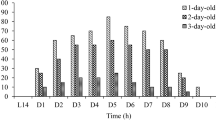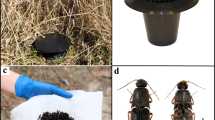Abstract
A gas chromatograph coupled with a behavioral bioassay was used to identify two sex pheromone components, 7-(Z)- and 7-(E)-tetradecen-2-one of the Oriental beetle (OB),Exomala orientalis. Field experiments showed that the blend of the two isomers (Z:E, 7:1) was not significantly more attractive than theZ component alone. The best performance of traps baited with the synthetic sex pheromone was achieved when they were set with the pheromone device at 30 cm above the ground. Catches in traps baited with 1 and 10 mg were not significantly different, but they were higher (2.9-fold) than captures in traps loaded with 0.1 mg of the pheromone. Further investigations by GC-EAD revealed the presence of a possible minor component, but the small amount of material prevented its identification. 2-(E)-Nonenol, with the same retention time as the natural product, did not affect the attractancy of the synthetic sex pheromone. GC-EAD screening of previously identified sex pheromones of scarab beetles showed that male antennae of the Oriental beetle responded to japonilure, but it showed neither synergism nor inhibition to the OB sex pheromone.
Similar content being viewed by others
References
Anonymous. 1980. Major Insect and Other Pests of Economic Plants in Japan. Japan Plant Protection Assoc., Tokyo.
Anonymous. 1987. Major Insect and Other Pests of Economic Plants in Japan. Society of Applied Entomology and Zoology (ed.). Japan Plant Protection Assoc., Tokyo.
Baraud, J. 1991. Nouvelle classification proposée pour les espèces du genreBlitopertha Reitter (1903) (Coleoptera: Rutelidae).Lambillionea 91:46–62.
Hasegawa, M., Leal, W.S., andSawada, M. 1993. Field evaluation ofAnomala schonfeldti Ohaus (Coleoptera: Scarabaeidae) synthetic sex pheromone.J. Chem. Ecol. 7:1453–1459.
Leal, W.S. 1991 (R,Z)-5-(-)-(Oct-1-enyl)oxacyclopentan-2-one, the sex pheromone of the scarab beetleAnomala cuprea.Naturwissenschaften 78:521–523.
Leal, W.S. 1993. (Z)-and (E)-Tetradec-7-en-2-one, a new type of sex pheromone from the Oriental beetle.Naturwissenschaften 80:86–87.
Leal, W.S., andMochizuki, F. 1993. Sex pheromone reception in the scarab beetleAnomala cuprea. Enantiomeric discrimination by sensilla placodea.Naturwissenschaften 80:278–281.
Leal, W.S., Mochizuki, F., Wakamura, S., andYasuda, T. 1992a. Electroantennographic detection ofAnomala cuprea sex pheromone.Appl. Entomol. Zool. 27:289–291.
Leal, W.S., Hasegawa, M., andSawada, M. 1992b. Identification ofAnomala schonfeldti sex pheromone by high-resolution GC-behavior bioassay.Naturwissenschaften 79:518–519.
Leal, W.S., Hasegawa, M., Mochizuki, F., andYasuda, T. 1992c. Behavioral and electrophysiological evidence of sex pheromone(s) inAnomala schonfeldti Ohaus (Coleoptera: Scarabaeidae).Appl. Entomol. Zool. 27:592–594.
Leal, W.S., Matsuyama, S., Suzuki, T., andOzawa, T. 1992d. GC-FTIR potential for structure elucidation.J. Braz. Chem. Soc. 3:25–29.
Leal, W.S., Roelofs, W.L., Zhang, A., Villani, M., Sawada, M., andHasegawa, M. 1993a. Sex pheromone of the Oriental beetle,Exomala orientalis. Program, 10th Annual ISCE Meeting, Clearwater Beach, Florida, p. 53.
Leal, W.S., Sawada, M., andHasegawa, M. 1993b. The scarab beetleAnomala cuprea utilizes the sex pheromone ofPopillia japonica as a minor component.J. Chem. Ecol. 19:1303–1313.
Leal, W.S., Sawada, M., Matsuyama, S., Kuwahara, Y., andHasegawa, M. 1993c. Unusual periodicity of sex pheromone production in the large black chaferHolotrichia parallela.J. Chem. Ecol. 19:1381–1391.
Leal, W.S., Sawada, M., andHasegawa, M. 1993d. The scarab beetleAnomala daimiana utilizes a bland of two otherAnomala spp. sex pheromones.Naturwissenschaften 80:181–183.
Leal, W.S., Kawamura, F., andOno, M. 1994a. The scarab beetleAnomala albopilosa sakishimana utilizes the same sex pheromone blend as a closely related and geographically isolated species,Anomala cuprea.J. Chem. Ecol. 20:1667–1676.
Leal, W.S., Hasegawa, M., Sawada, M., Ono, M., andUeda, Y. 1994b. Identification and field evaluation ofAnomala octiescostata (Coleoptera: Scarabaeidae) sex pheromone.J. Chem. Ecol. 20:1643–1655.
Murayama, J. 1950.Phyllopertha orientalis, p. 1319,in T. Esaki, T. Ishii, T. Kawamura, S. Kinoshita, S. Kuwayama, T. Shiraki, and S. Uchida (eds.). Iconographia Insectorum Japonicorum. Hokuryu-kan Publishing Co., Tokyo.
Potts, R.W.L. 1974. Revision of the Scarabaeidae: Anomalinae. 1. The genera occurring in the United States and Canada.Pan-Pac. Entomol. 50: 148–154.
SAS Institute. 1989. Software for Statistical Visualization on the Apple® Macintosh. JMP® Introductory Guide. SAS Institute, Inc., Cary, North Carolina.
Stoetzel, M.B. 1989. Common Names of Insects & Related Organisms. Entomology Society of America, Lanham, Maryland.
Tashiro, H. 1987. Turfgrass Insects of the United States and Canada. Cornell University Press, Ithaca, New York, 474 pp.
Author information
Authors and Affiliations
Rights and permissions
About this article
Cite this article
Leal, W.S., Hasegawa, M., Sawada, M. et al. Sex pheromone of oriental beetle,Exomala orientalis: Identification and field evaluation. J Chem Ecol 20, 1705–1718 (1994). https://doi.org/10.1007/BF02059892
Received:
Accepted:
Issue Date:
DOI: https://doi.org/10.1007/BF02059892




